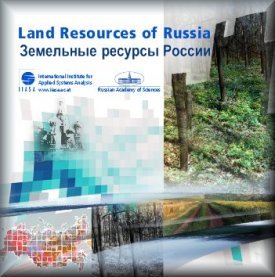Version
1.1
Copyright © 2002, IIASA & RAS
All Rights Reserved
Copyright © 2002, IIASA & RAS
All Rights Reserved
 Land
is a complex system of interrelated elements composed of biophysical
and socioeconomic characteristics. Russia occupies 1,709 million hectares
(ha) of land, about one-seventh of the global land area. This vast land
contains a large diversity of natural and socioeconomic conditions that
are reflected in countrywide inventories. Many scientists and various
governmental organizations and institutions conducted long-term inventories
and research aimed at gathering reliable and comprehensive information
on the country's land resources. Systematic research was carried out
with respect to Siberia and the Far East of Russia within the framework
of the settlement program at the end of the 19th and 20th centuries.
At the country scale, an intensive study was performed under the Government's
Plan for Electrification of Russia (GOELRO), the establishment of collective
farming (Collectivization) in the 1930s and 1940s, the "Plan for
Transforming Nature" (end of the 1950s), and the "Plan for
Development of Virgin and Abundant Lands" (early 1960s). During
the last decades, substantial investigations were undertaken, among
others, by the Council on Productive Facilities (SOPS) of the Russian
Academy of Sciences, and by special government surveys on land (ROSKOMZEM),
forests (ROSKOMLES), and land amelioration (MINVODHOZ). These efforts
have resulted in a large volume of well-documented and published, mapped
and descriptive data and stored archive information. However, for various
reasons this valuable information is not widely used by Russian policymakers
and scientists and is practically unknown abroad. In many cases, major
global international programs suffer from a deficit of data on Russian
land. These international programs are often forced to develop their
own databases on Russian land, based on accessible data of varying quality.
These efforts have resulted in a large number of contradicting figures
describing the land of Russia. This CD-ROM on Russia's land resources
will be an aid to overcoming the information deficits mentioned above.
Land
is a complex system of interrelated elements composed of biophysical
and socioeconomic characteristics. Russia occupies 1,709 million hectares
(ha) of land, about one-seventh of the global land area. This vast land
contains a large diversity of natural and socioeconomic conditions that
are reflected in countrywide inventories. Many scientists and various
governmental organizations and institutions conducted long-term inventories
and research aimed at gathering reliable and comprehensive information
on the country's land resources. Systematic research was carried out
with respect to Siberia and the Far East of Russia within the framework
of the settlement program at the end of the 19th and 20th centuries.
At the country scale, an intensive study was performed under the Government's
Plan for Electrification of Russia (GOELRO), the establishment of collective
farming (Collectivization) in the 1930s and 1940s, the "Plan for
Transforming Nature" (end of the 1950s), and the "Plan for
Development of Virgin and Abundant Lands" (early 1960s). During
the last decades, substantial investigations were undertaken, among
others, by the Council on Productive Facilities (SOPS) of the Russian
Academy of Sciences, and by special government surveys on land (ROSKOMZEM),
forests (ROSKOMLES), and land amelioration (MINVODHOZ). These efforts
have resulted in a large volume of well-documented and published, mapped
and descriptive data and stored archive information. However, for various
reasons this valuable information is not widely used by Russian policymakers
and scientists and is practically unknown abroad. In many cases, major
global international programs suffer from a deficit of data on Russian
land. These international programs are often forced to develop their
own databases on Russian land, based on accessible data of varying quality.
These efforts have resulted in a large number of contradicting figures
describing the land of Russia. This CD-ROM on Russia's land resources
will be an aid to overcoming the information deficits mentioned above.
The overall objective of the CD-ROM is to answer the need for a harmonized
collection of integrated data on the land resources of Russia, as described
in Chapter 10, Agenda 21 of UNCED. Today's dynamic society has been
facing increasingly complex, closely interrelated, and rapidly spreading
problems. Numerous scientists and policy-decision makers around the
world are looking for integrated, holistic information that will enable
them to undertake proper, timely, and relevant actions. They are preparing
to aim modern and highly advanced technologies at effective management,
hoping to help the world adapt to new realities. This CD-ROM is in line
with these efforts and proposes new perspectives for encouraging land
resources development in Russia.
The
CD-ROM contains specially selected data. They are: (1) complete, (2)
complex, (3) consistent, and (4) uniform. These data have been adapted
from the latest available sources and centered on three major themes:
socioeconomics (statistics and infrastructure); natural conditions (climate,
hydrology, permafrost, relief, lithology, vegetation, soils, biodiversity,
ecosystems, and land cover); and land endowment (land use, agriculture,
forest use, land productivity, desertification, and land degradation).
Maps, descriptive text, and an explanatory glossary illustrate the databases
presented. For users interested in further details of a topic, basic
references are provided.
The CD-ROM production was initiated and supported by the Russian Committee
of Systems Analysis of the Russian Academy of Sciences and the Forestry
project of the International Institute for Applied Systems Analysis
(IIASA). The baseline data have been developed at IIASA with considerable
contributions from various institutes and organizations within Russia.
